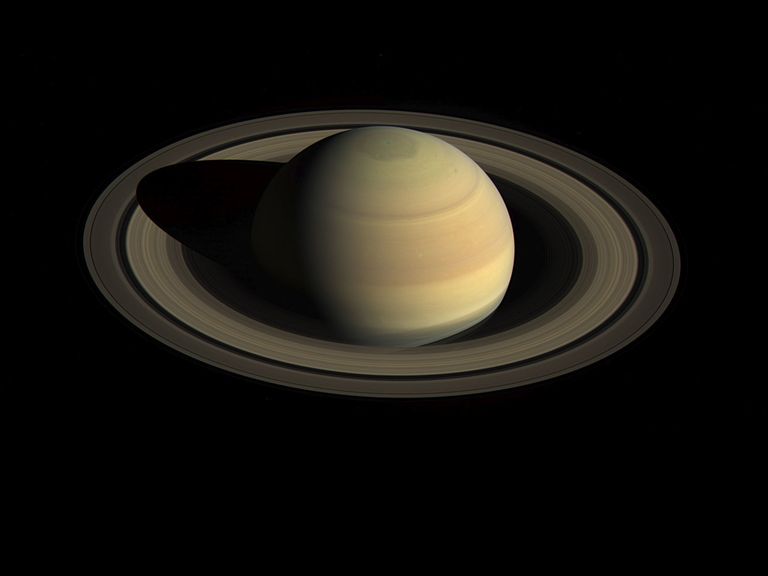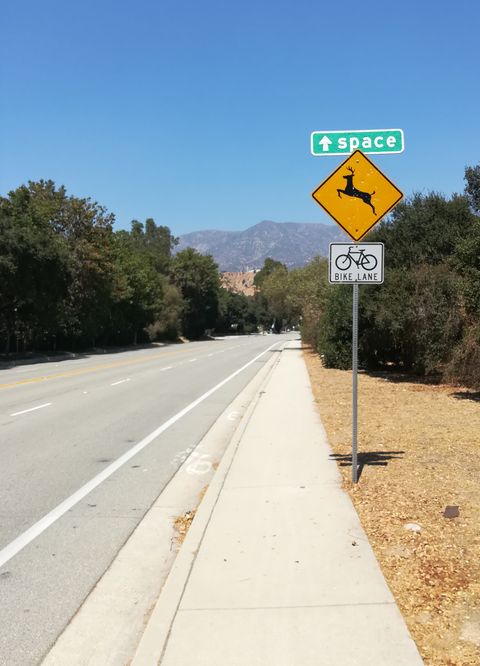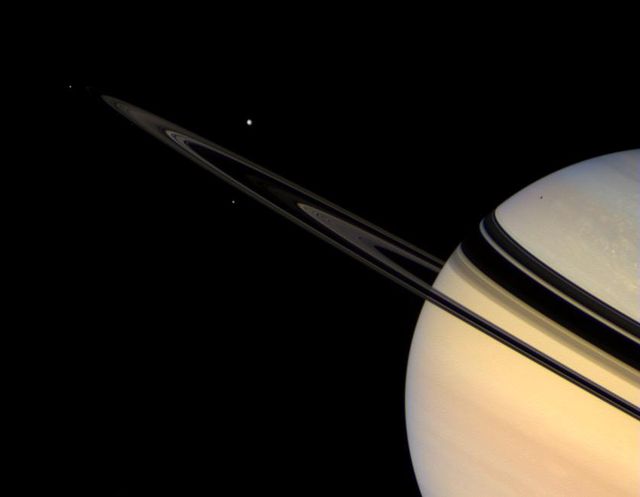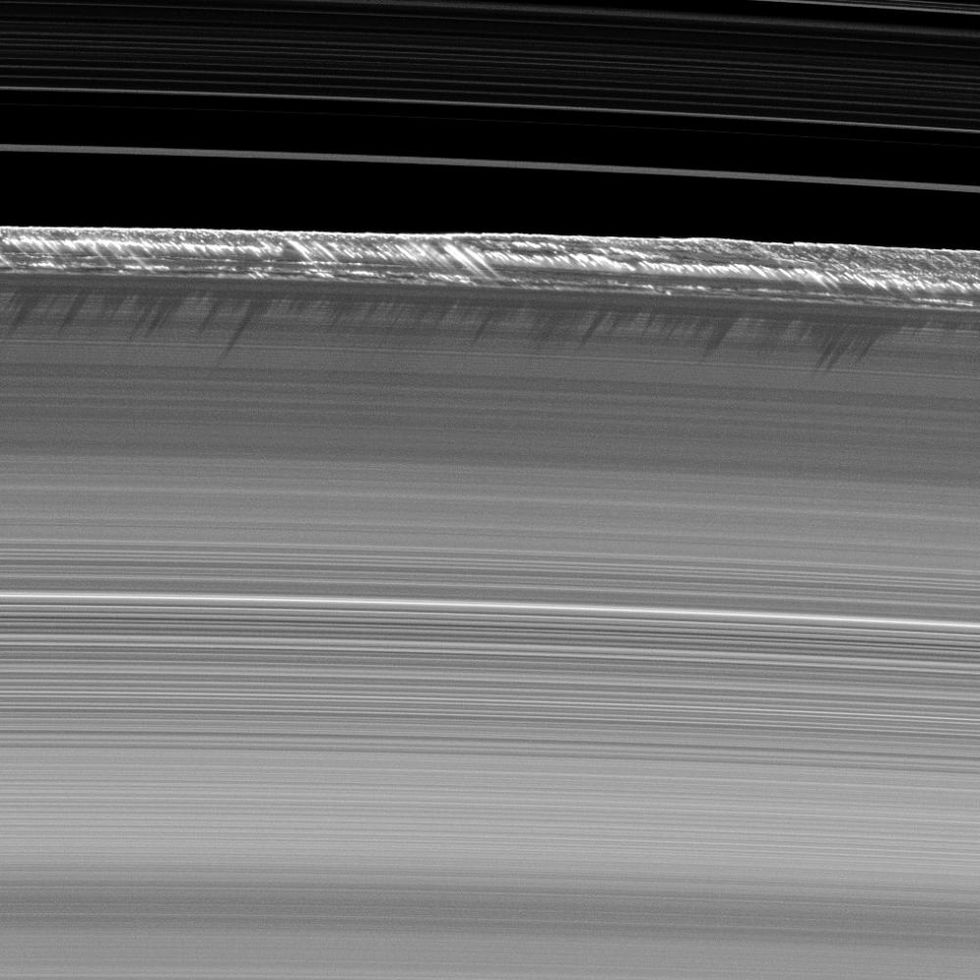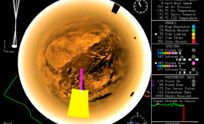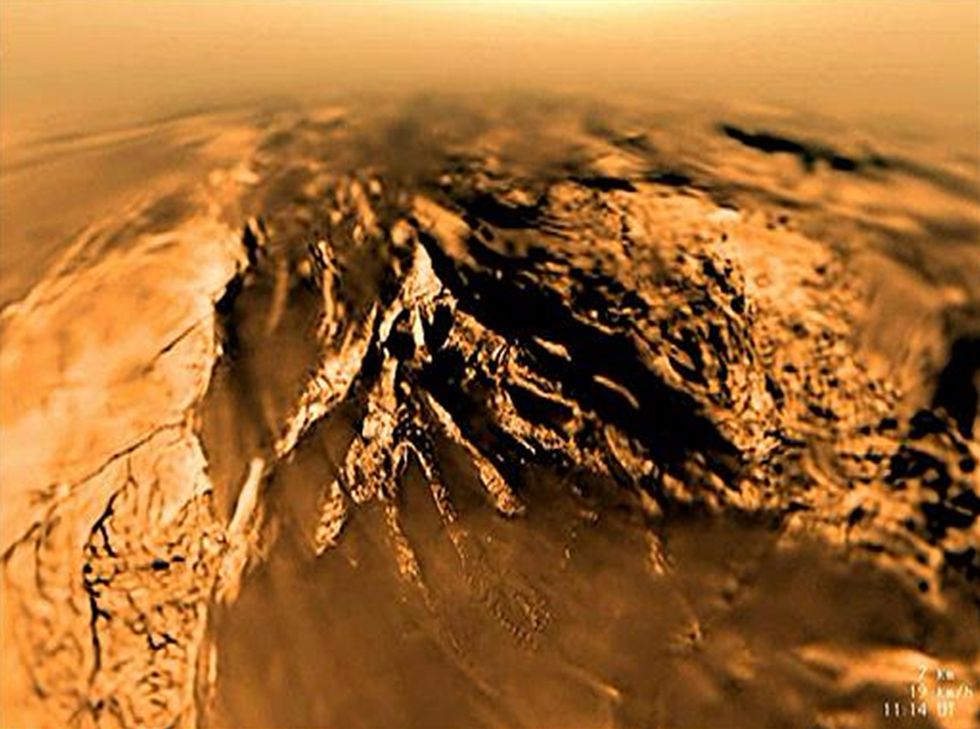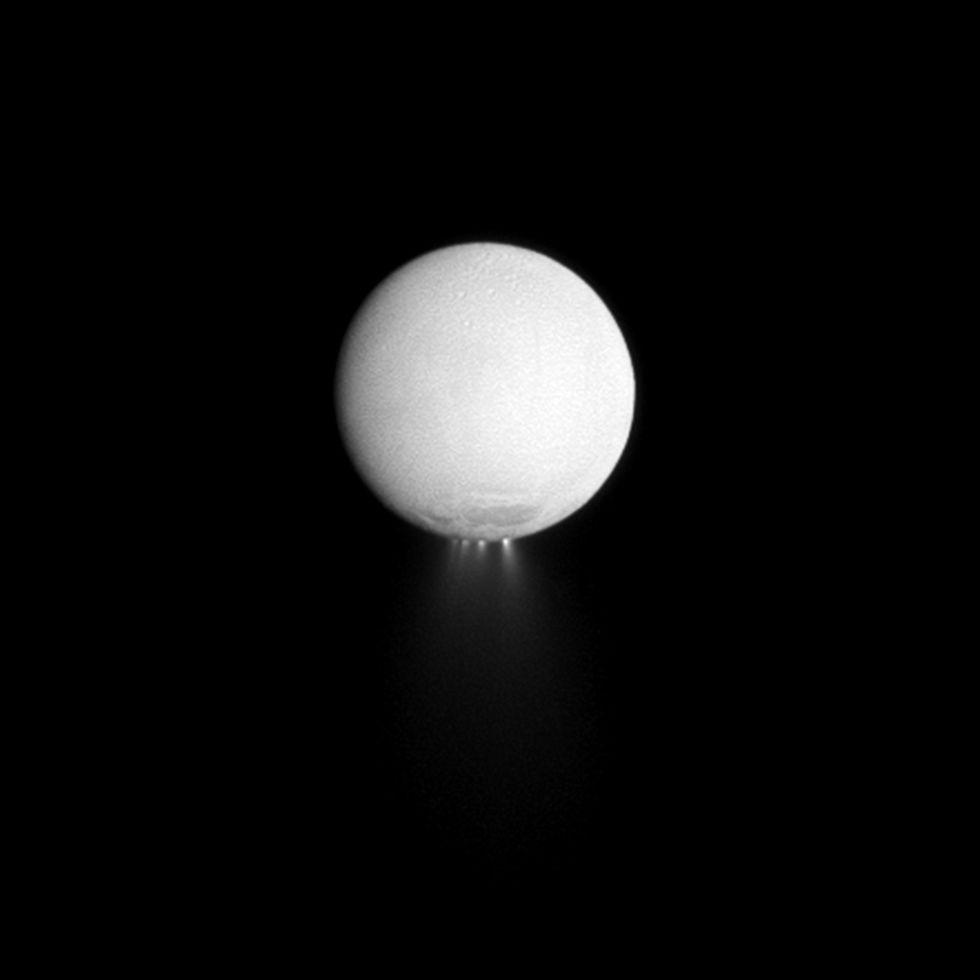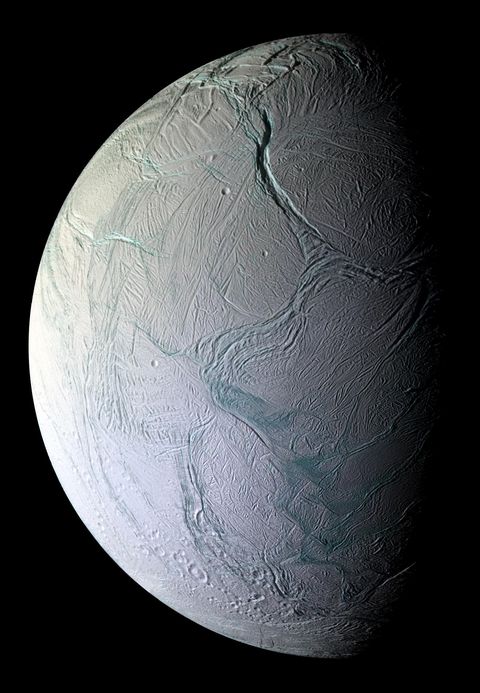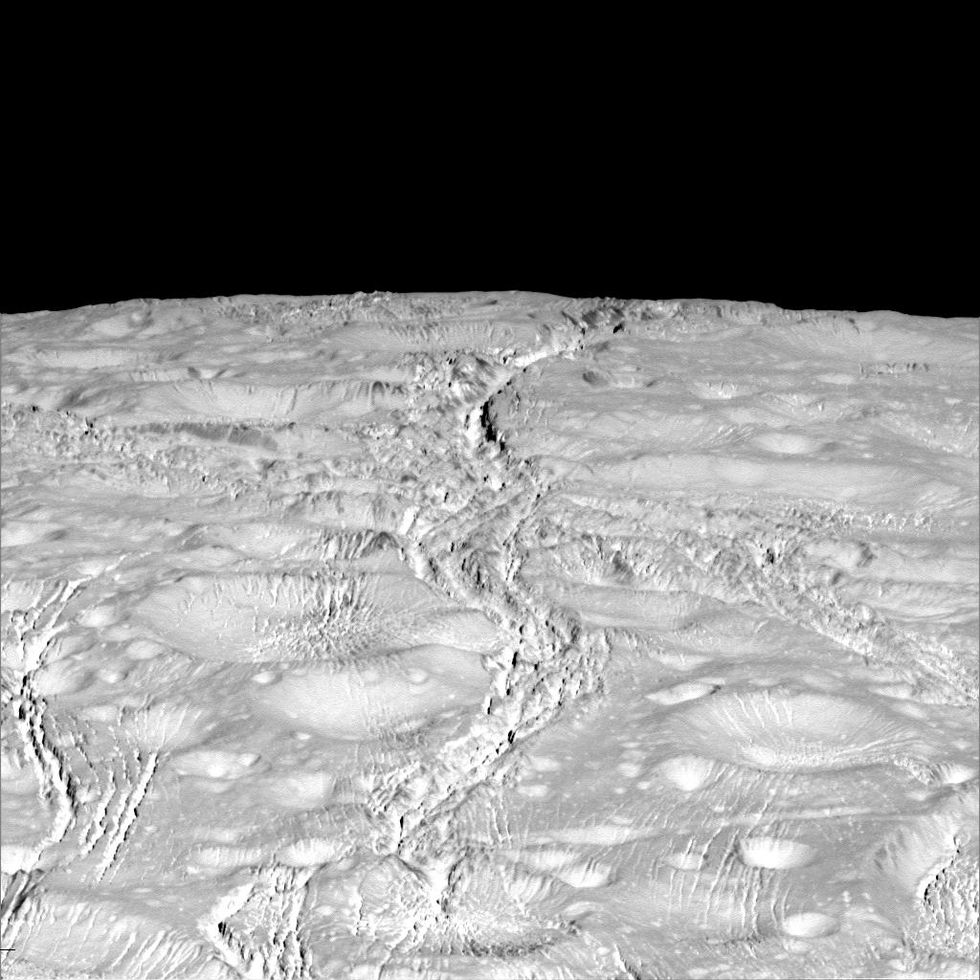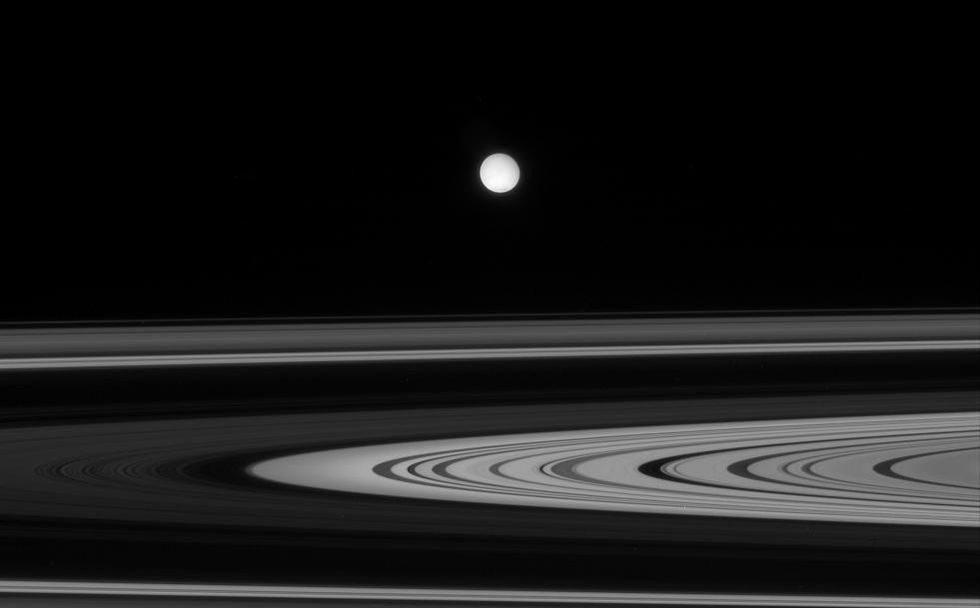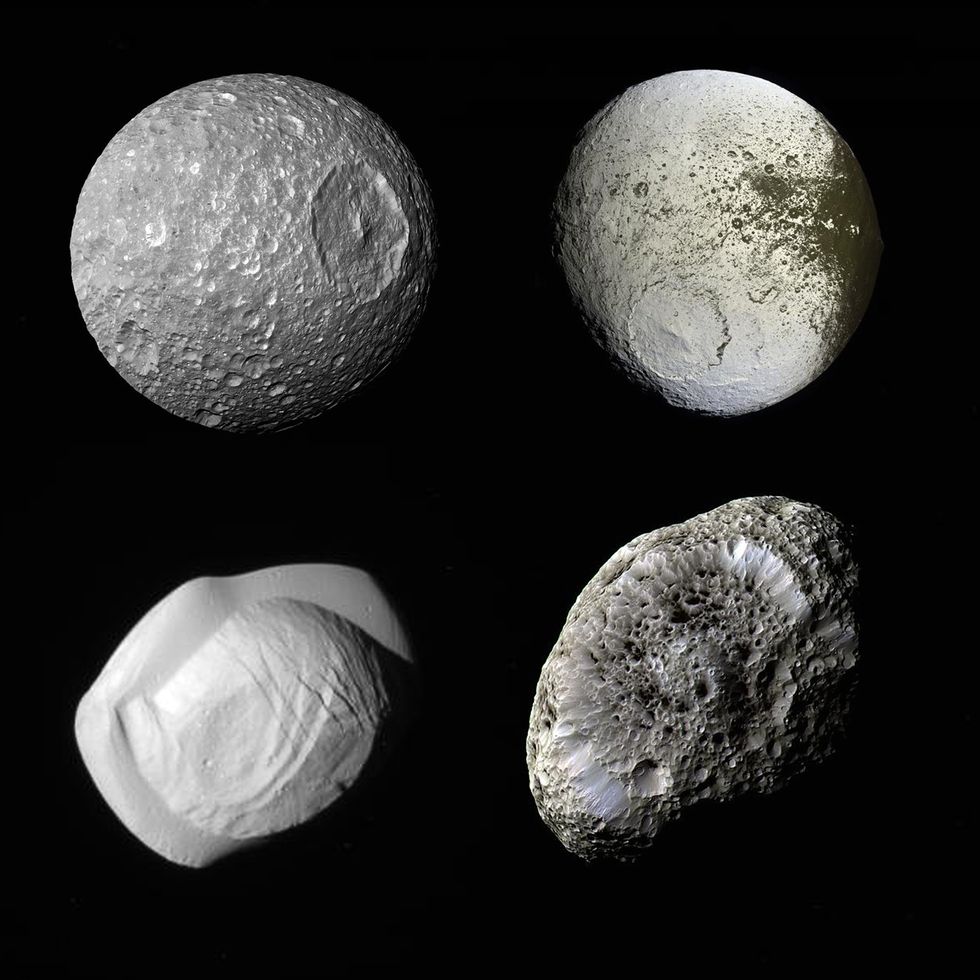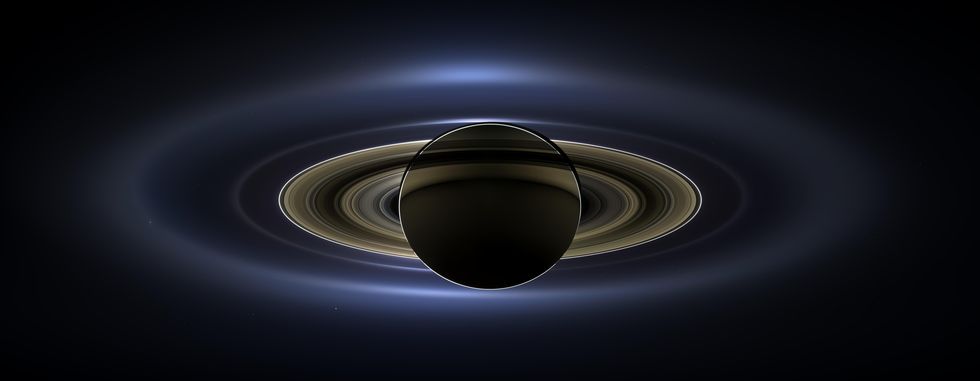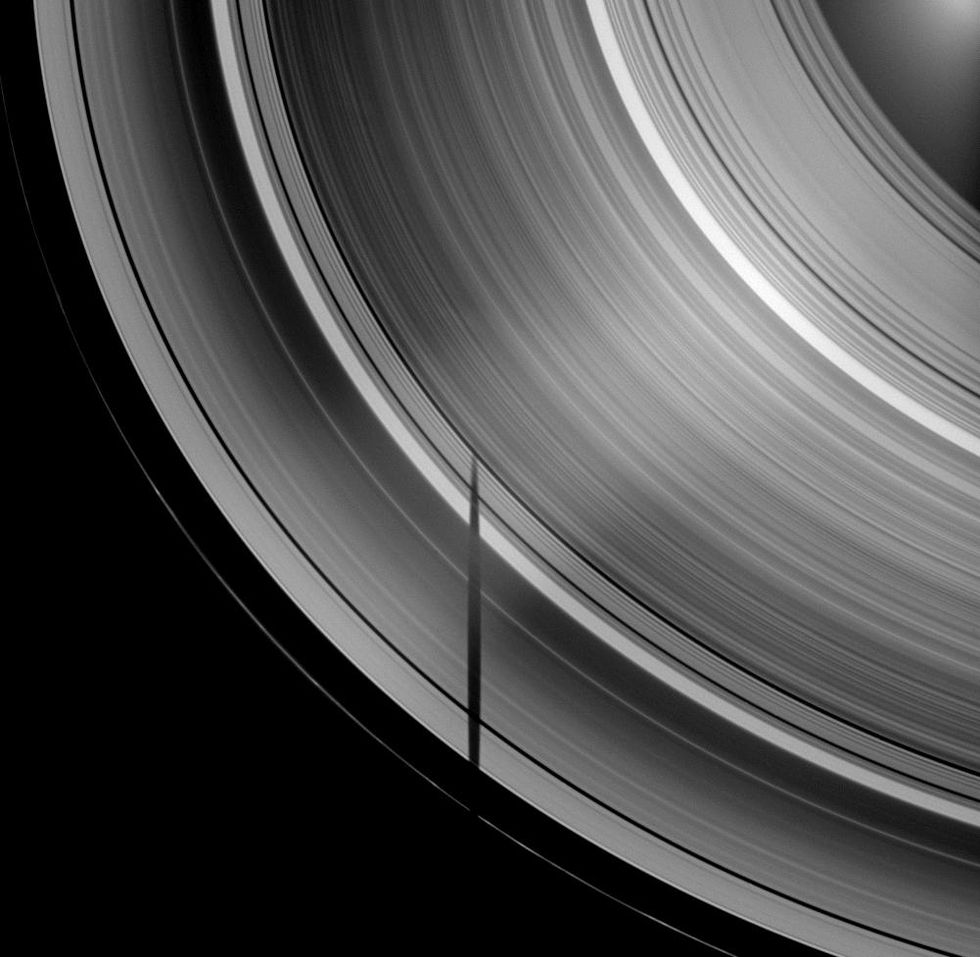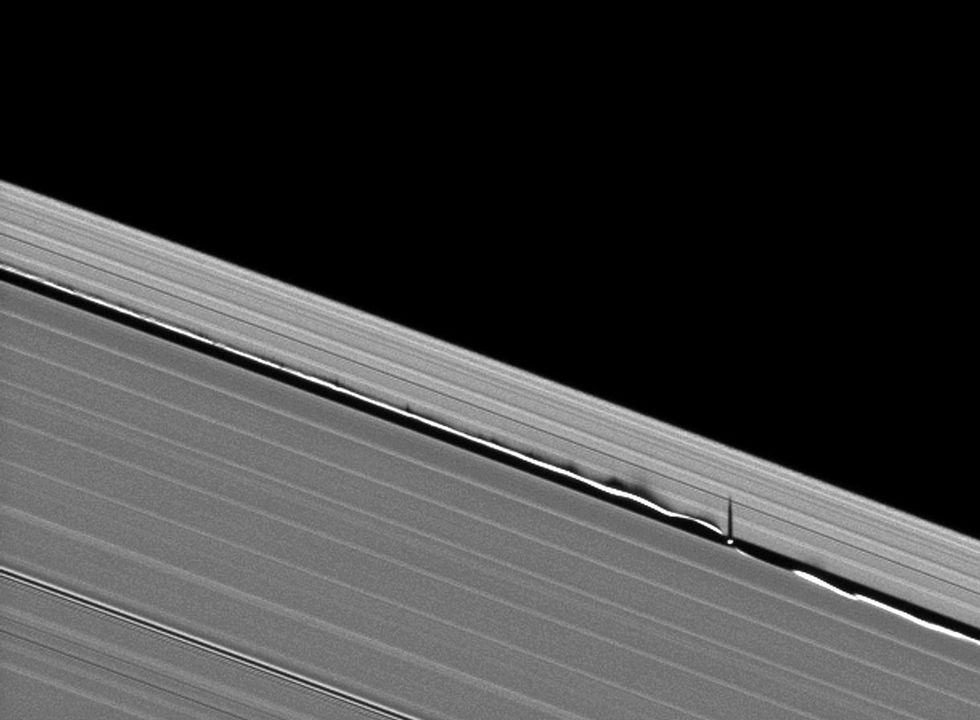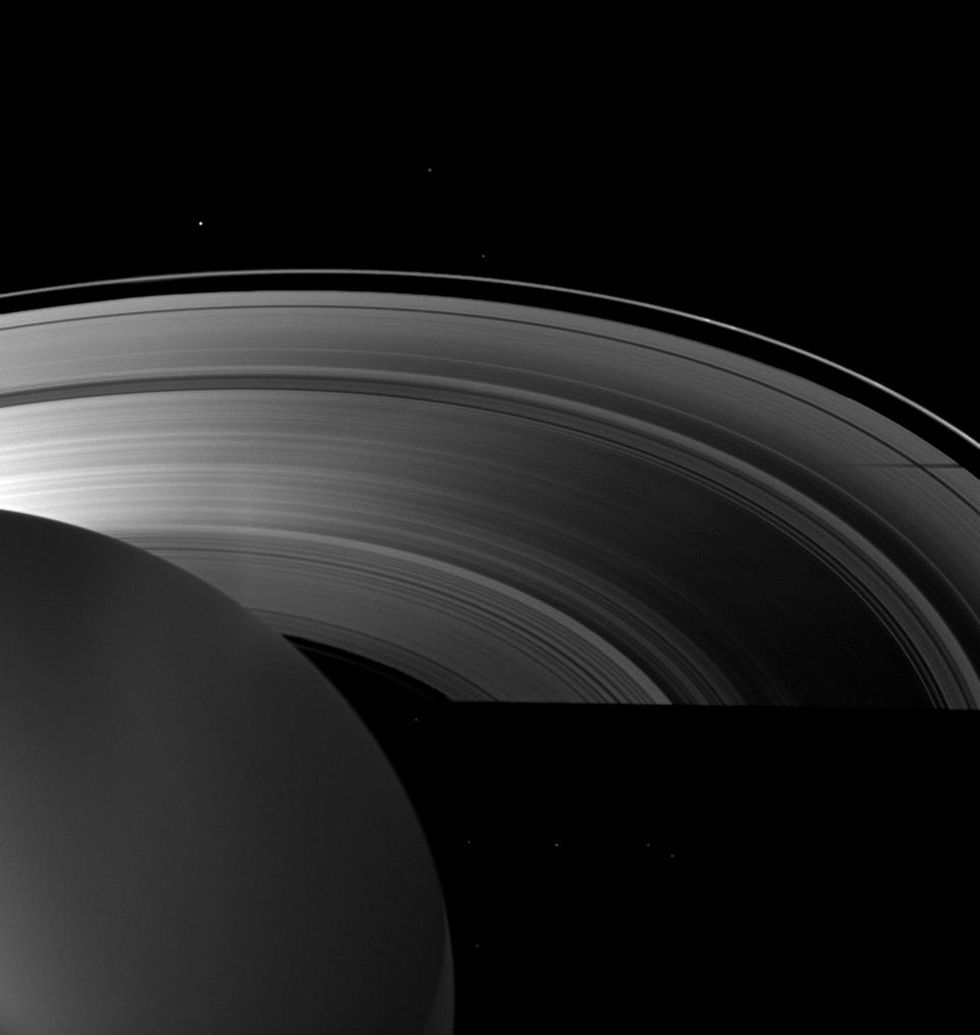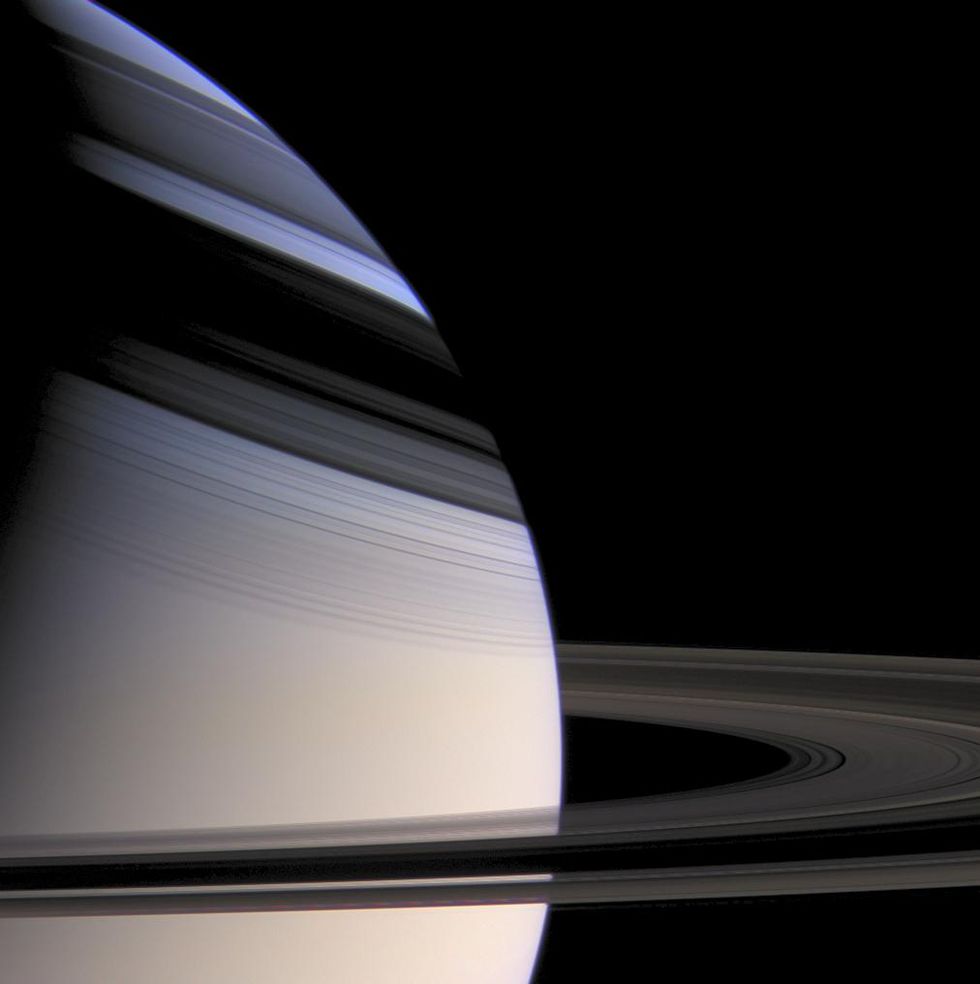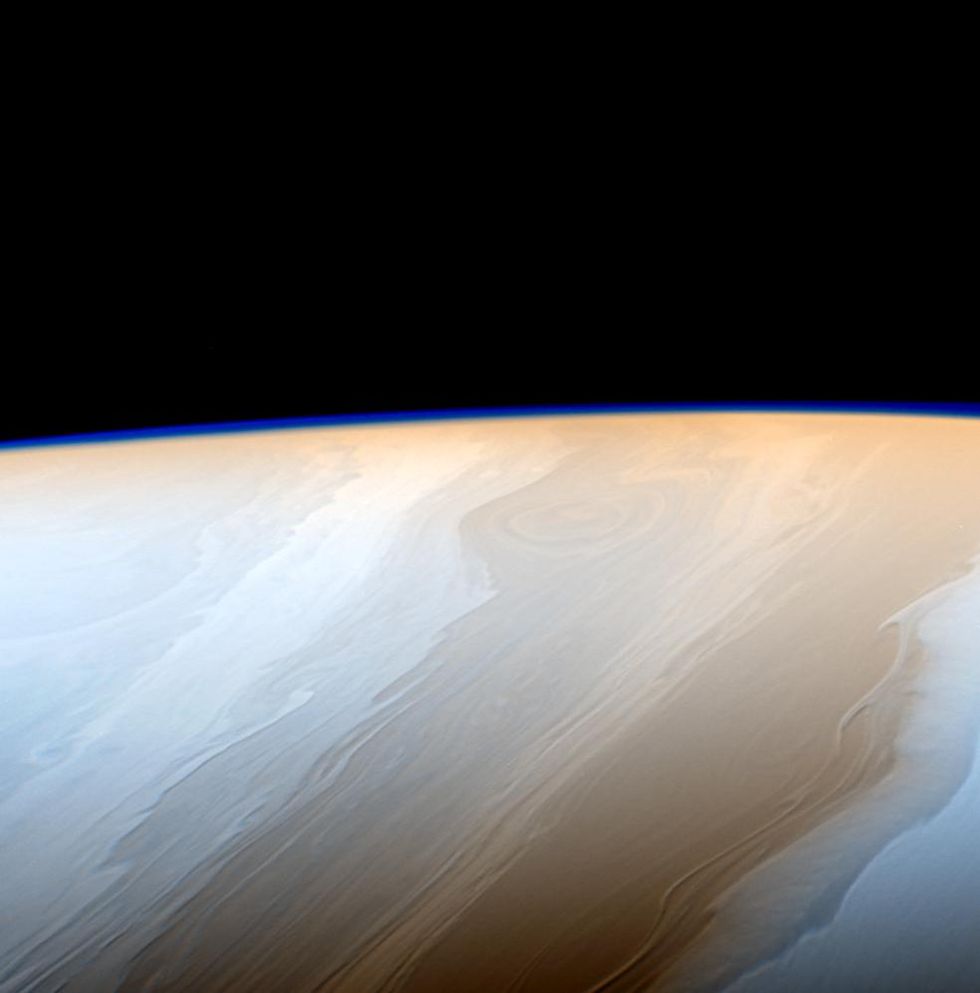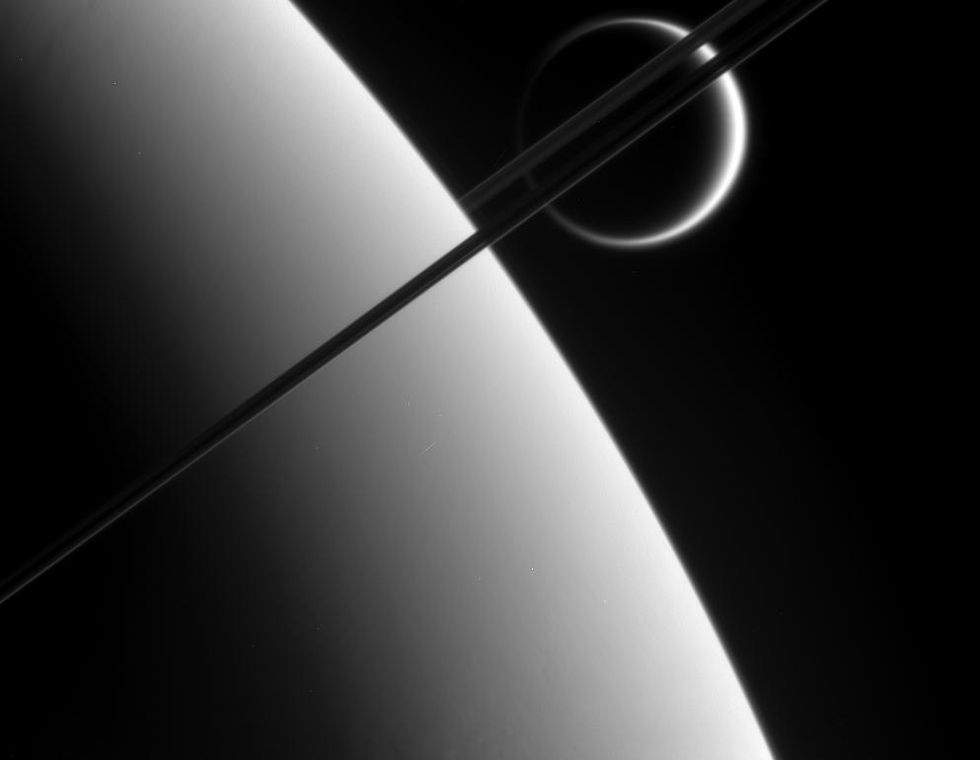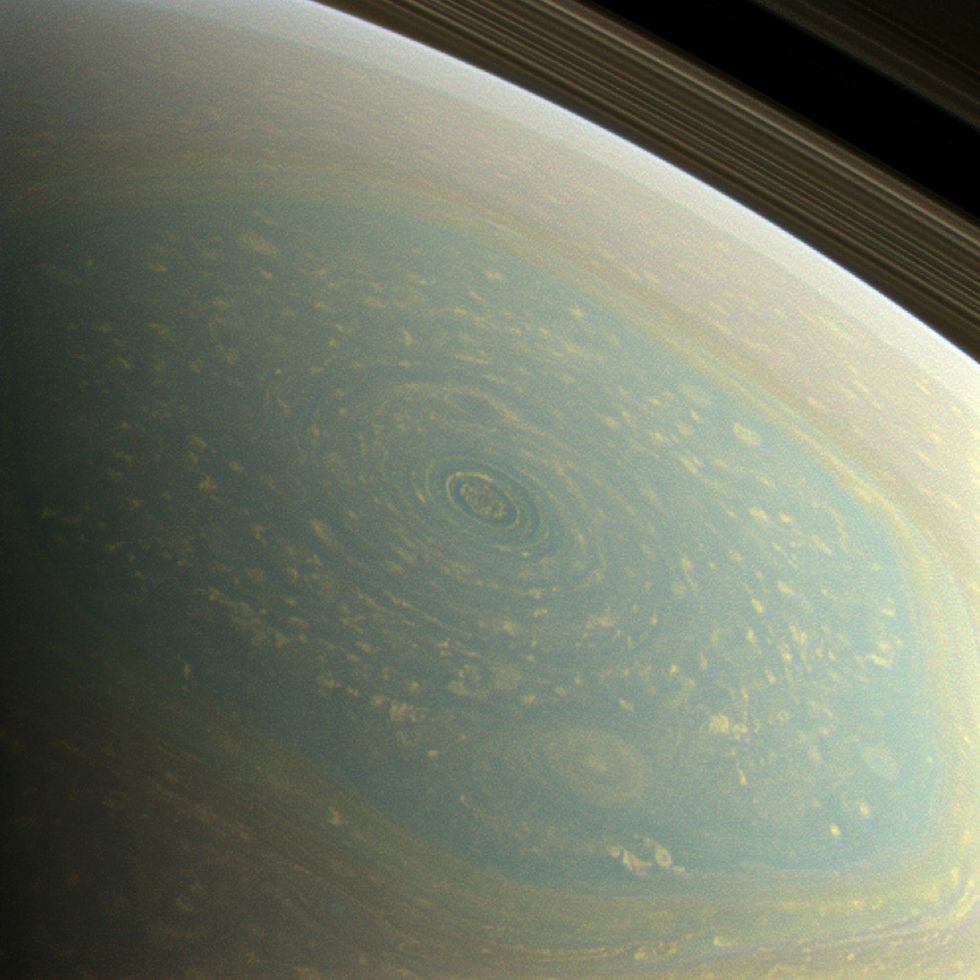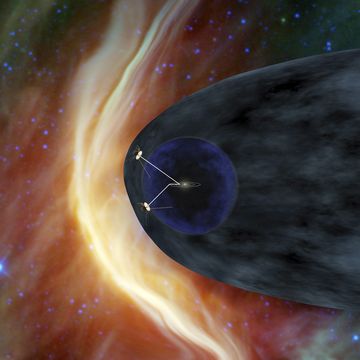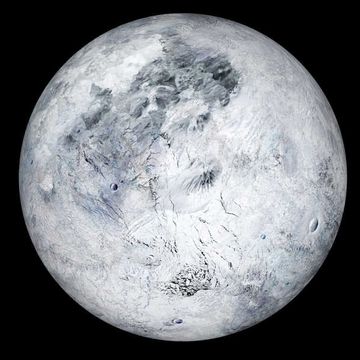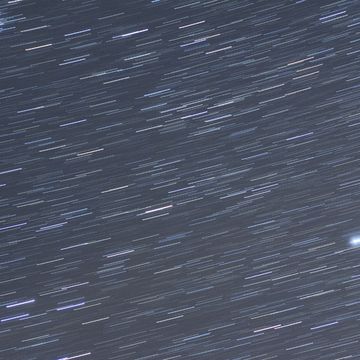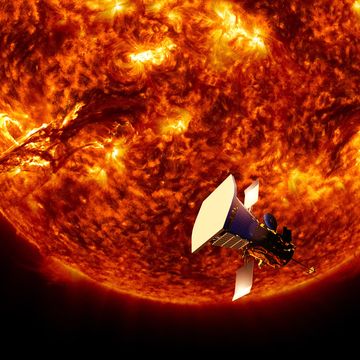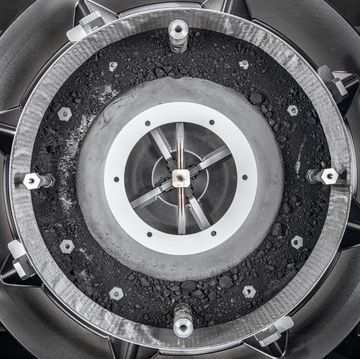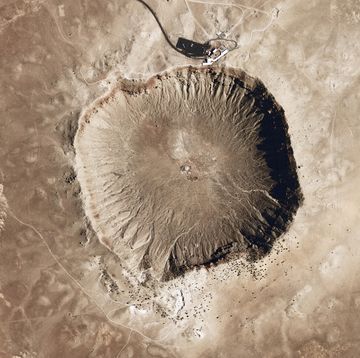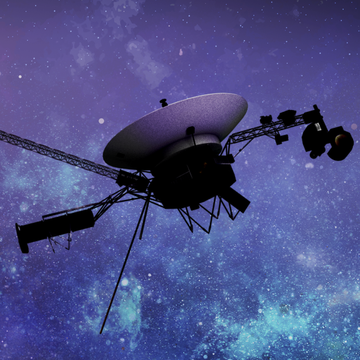The Cassini spacecraft spent 13 years orbiting Saturn. It revealed the planet and its rings in striking detail, found liquid around every corner, and invigorated the idea that alien life not only exists, but could be right on our doorstep.
A strange device sits on the end table, a few dozen vertical light strips around a thicker column in the center, like a tall model carousel. Light trickles down the strips, then up. On the center column, the names of spacecraft scroll by on an LED display: VOYAGER. MER-B (for Mars Exploration Rover B, better known as Opportunity).
"This is connected to the Deep Space Network," says Charles Elachi, professor emeritus of planetary science at Caltech and the director of NASA's Jet Propulsion Laboratory from 2001 to 2016. "When you see light coming down, that means you are receiving data from the satellite, and when you see light going up, that means you are sending commands."
The Deep Space Network consists of three stations of enormous radio telescope receivers placed around the globe in California, Spain, and Australia. This way, NASA can communicate with any of its spacecraft at any time. The control center is right here in Pasadena. Whenever the network talks to a spacecraft, the electric apparatus in Elachi's office lights up. His foot-tall model is a desktop version of a room-sized DSN indicator at JPL, down the road from Caltech. The device was a gift to Elachi after he retired as director of the renowned NASA lab.
The white carousel never stays dark for more than a few seconds. And every now and then, CASSINI floats across the central column, indicating a connection with the bus-sized spacecraft that has been orbiting Saturn for the last 13 years. "From just the breadth of scientific discoveries and breadth of what it looked at, it's probably the richest mission ever undertaken by NASA," Elachi says.
But Cassini will not light up his end table contraption for much longer. The spacecraft's fuel tanks are almost dry, and on Friday, September 15, Cassini will fly into the atmosphere of Saturn and burn up among the high clouds, never again to talk to Earth.
Where Spring Lasts 7 Years
Launched on October 15, 1997, Cassini traveled for six years and 261 days before reaching Saturn. Though the sixth planet lies an average of 890 million miles from Earth, Cassini flew some 2.2 billion miles to get there via the scenic route: orbiting the sun to fly by Venus twice, then Earth, then to a gravity assist maneuver at Jupiter before reaching its destination. The craft has been orbiting the ringed planet since July 1, 2004, studying Saturn's fascinating moons, tiny ring particles, and turbulent atmospheric storms—including a gargantuan hexagonal vortex at the north pole that could swallow the Earth whole.
It has been a journey of unprecedented discovery. "It may go down as one of NASA's greatest planetary missions, simply because we've had a fire hose of data come back over 13 years," says Linda Spilker, Cassini Project Scientist. Spilker, a veteran of the Voyager mission, has been working on Cassini for decades, yet you need only ask her about the composition of Saturn's great rings or the icy geysers erupting from Enceladus, and the sparkle of discovery lights up in her eyes. "We have literally rewritten the textbooks about the Saturn system," she says.
The mission began with a daredevil flight. Cassini entered Saturn's orbit by flying up through the rings, a maneuver that required the spacecraft to point its radio dish away from Earth and use it as a shield to block any debris that might hit the craft. Elachi called the orbital insertion "the most tense" part of the entire mission.
"I remember very clearly we were in the mission operation room, and we were coming close, you know, to fire the engine, and here we have an engine which we have fired only once over seven years, and it had to work," the former JPL director recalls. "You can imagine the tension that was in the room, in the mission operation room when we were waiting to get the signal that the engine had fired."
Thirteen years and two months later, and the Cassini team has watched Saturn go through nearly two whole Saturnian seasons. One trip around the sun for Saturn takes about 29 Earth years, meaning each season lasts a little more than 7 years. Cassini arrived during wintertime in the planet's northern hemisphere, but winter faded into spring shortly after the conclusion of the spacecraft's primary mission in 2008.
Cassini earned two extensions to keep it going. During the two-year Equinox Mission, so-named because it included the spring Equinox of Saturn in August 2009, scientists glimpsed exactly how far icicle spires and pillars stretched above and below the rings of Saturn, as evidenced by their shadows as the sunlight hit the rings directly. The second mission extension came in February 2010—the Solstice Mission. This seven-year extension of science operations would go on to study the Saturn system until shortly after its summer solstice, the longest day in Saturn's northern hemisphere and the shortest in the south. The Solstice Mission shall be Cassini's final mission, and it is drawing to a close.
The Grand Finale of Cassini, now under way, involves a series of 22 orbits that send the spacecraft in between the great gas planet and its majestic rings, an area of the solar system that had never been visited before. Cassini has been beaming back precious images of the planet's surface and rings in unprecedented detail. It will continue to transmit data on September 15 until the spacecraft burns up in the Saturnian sky, forever to remain a part of the planet.
But when Cassini first arrived at Saturn back in 2004, it had another target in its sights: the great moon of Titan, one of the most marvelous places in the solar system.
Mountains of Ice, Seas of Methane
Titan, a moon larger than the planet Mercury, has been shrouded in mystery for centuries. The largest moon of Saturn was discovered in 1655 by Dutch astronomer Christiaan Huygens. It was the sixth moon ever discovered, following our own and the four Galilean moons around Jupiter.
The Pioneer 11 spacecraft visited in 1979 and revealed Saturn's largest moon to be cold, but blanketed with a thick atmosphere. Voyager 1 flew by at about 4,000 miles from the moon in 1980 to measure the composition and pressure of Titan's nitrogen-rich atmosphere. Although it could not peer through the atmospheric haze, Voyager's readings suggested that the surface of Titan could support channels and even lakes of liquid methane.
Cassini went to find out for sure, not only by mapping the moon with radar instruments, but also by carrying a buddy probe. The mothership deployed a small lander built by the European Space Agency called Huygens, named for Titan's discoverer. The craft would land on the mysterious moon using parachutes to slow down in the thick atmosphere.
When Huygens landed on Titan in January 2005, it became the most distant planetary landing ever achieved by humankind—a record the probe will likely retain for years or even decades. Images from Huygens' landing on Titan revealed a dynamic world of ice mountains laced with flowing channels of liquid hydrocarbons. Years of radar and spectroscopy observations from Cassini have pinpointed large hydrocarbon oceans around the poles and measured an active weather cycle of evaporation and rain. It's similar to Earth—except the rocks on Titan are made of water ice and the rains are liquid methane.
"It has the same cycle that you see on our planet," says Elachi, who studied Cassini's radar data of Titan. "You have clouds. They have rain. You have rivers. You have lakes. It evaporates, goes up, but it's all made of organic material, you know, ethane and methane. It's kind of similar to gasoline."
Planetary scientists say that Titan today could be similar to what Earth was like billions of years ago, before life took root and transformed our home planet. If this is true, then perhaps Titan will be habitable in hundreds of millions of years. Perhaps the very first processes, the first primordial mixings needed to spark life, are already underway beneath the smoggy nitrogen atmosphere. Scientists believe there is ample energy and heat for a liquid water ocean under the methane lakes and icy outer crust of the giant moon. Perhaps there is even life on Titan right now.
"I wouldn't be surprised if we can find some kind of life on Titan that is different than the life here," Elachi says. "It might be based on carbon and hydrocarbon. And Titan is much colder, so it might have to be a different kind of life that adapts to it." You wouldn't think life could survive in such extreme conditions, he says, and yet it thrives in locations on Earth that seem entirely inhospitable, such as the deepest depths of the ocean and even in burning pools of acid in the desert. "So it's not crazy. Let's put it that way. We don't have any proof, and we don't have an example, but it's not crazy to think that there might be some form of organic life on Titan."
In 2017, the prospect of life on Titan became even more exciting as the Cassini team discovered a chemical on the large moon, vinyl cyanide, has the physical properties required to form cell membranes. But when it comes to life, Titan may not be the best place to look, even in the Saturn system.
10,000-Foot Geysers
Titan's smaller neighbor Enceladus is about 314 miles wide, making it only about 4 percent the size of Earth. Yet this small moon captured the imagination of the world in 2005 when Cassini photographed something astonishing on the icy surface. Enceladus images revealed geysers of water vapor, ice, and other particles erupting from the surface of the moon thousands of feet out into space. The science team was stunned.
"You have water shooting out of that planet [Enceladus] up to literally tens of thousands of feet," says Elachi. "So just imagine you are standing at Yellowstone and you see a geyser which goes all the way up to where a jet airline is flying."
The original Cassini mission included just three flybys of Enceladus, previously thought to be a dull ball of solid ice. After the plumes were spotted, the Cassini team rewrote mission objectives, changed flight trajectories, and now Cassini has conducted 22 close flybys of Enceladus. By 2015, the team had confirmed that the plumes didn't come from an isolated warm reservoir of water, but a global subsurface ocean that envelops the moon underneath roughly 20 miles of icy crust. One of the primary reasons the Cassini team will have the spacecraft plunge into Saturn at the end of the mission is to ensure that it will never mistakenly impact this pristine watery moon.
The Enceladus flybys included multiple passes through the plumes themselves, including one that saw the spacecraft fly within 30 miles of the surface of the moon. Cassini was not outfitted to study these particles directly—no one even knew the geysers existed before the spacecraft's arrival—but scientists were able to make good use of two tools on the craft.
The breakthrough came in April 2017, when the science team announced that Cassini found evidence of hydrothermal vents on Enceladus—great volcanic fissures in the seafloor that release geothermal heat and abundant nutrients into the water. The spacecraft detected abundant molecular hydrogen in the plumes of Enceladus, an indication of vents, using its Ion and Neutral Mass Spectrometer (INMS) designed to sample gaseous materials in Titan's atmosphere. The science team also found nano-silica grains in the plumes that only form in water near the boiling point using Cassini's Cosmic Dust Analyzer (CDA), an instrument designed primarily for Saturn's rings to analyze particles up to one-thousandth of a millimeter, the size of smoke particles.
On Earth, hydrothermal vents support entire ecosystems of microbes as well as macro-level life including tube worms, crabs, and small fish, all living at depths in the ocean where no sunlight penetrates and the pressure is high enough to crush most submarines. Some abiogenesists—people who study how organic chemical reactions could spark biological life—think the very first life on Earth formed around these deep ocean vents.
Unlike Titan, everything that we consider a prerequisite for life on Earth is also found on Saturn's small watery moon. "Unfortunately, Cassini doesn't have the instruments to make the measurements to look for those big molecules and to look for evidence of life," says Spilker. "So this means we have to go back."
Spilker is currently working on a mission proposal for NASA's New Frontiers program. It would be called the Enceladus Life Finder, or ELF. The spacecraft would orbit Saturn and make multiple close flybys of Enceladus to directly sample the plumes with instruments that could identify larger particles, such as fatty acids or amino acids, that could be indicative of life.
"The mission is a series of orbits through the plume of Enceladus carrying the instruments that you would need to sample it and make the measurements to better characterize the ocean of Enceladus," says Spilker. "Then make some key measurements to try and answer the question: Is there life in the ocean of Enceladus?"
Although Titan and Enceladus are the most tantalizing of Saturn's moons, Cassini has revealed strange and marvelous facts about many of the gas giant's 62 confirmed natural satellites. The biggest by radius are Titan, Rhea, Iapetus, Dione, Tethys, Enceladus, and Mimas. Most of these worlds have surface crusts of ice and rock, and some, like Rhea and Dione, are thought to harbor subterranean oceans similar to Enceladus.
A great crater on Mimas, the smallest object in the solar system known to be spherical due to self-gravitation, makes the little world resemble the Death Star. Iapetus has a massive equatorial ridge—reaching heights of more than 12 miles, more than twice the height of Mount Everest—that runs three-fourths of the way around the moon. In addition, Iapetus itself is two colors, bright white on one side and dark brown on the other. Many of Saturn's larger moons have faint, wispy rings as well, trading particles with the rings of the planet.
Thanks to Cassini, we know the moons of Saturn more intimately than any other rocky worlds beyond the asteroid belt. These planetary bodies have liquids, they have water, they have atmospheres. The findings have shown that even hundreds of millions of miles from the warmth of a star, planets and moons can have active geology, flowing liquid, and abundant energy. Everything Cassini has shown us indicates that somewhere, lurking under the icy crust of Enceladus or swimming through the methane seas of Titan, there could even be life.
A Plane of Icy Particles
Saturn, of course, is most famous for its extensive ring system—an equatorial plane encircling the planet that is 30 feet wide at most, full of icy particles that range in size from micrometer specks (smaller than the width of a human hair) to boulders. With its many rings and moons, the Saturn system is a kind of micro-solar system to study, and the secrets of how it evolved could tell us something fundamental about how the whole solar system formed.
The Cassini team was surprised to find that, by and large, the ring particles of Saturn are not singular orbs floating around and occasionally crashing into each other as they circle the planet. The particles instead hit each other and clump together. Spilker, who specialized in studying the ring data from Cassini, says it looks a little like "parallel granola bars. We had hints of that in the optical data, too, because as you went around the ring, the brightness would change in a way that wasn't expected. But if you pop in the granola bar—it's called self gravity wakes—pop in that model, okay, everything works."
There are a few rogue objects floating around Saturn's ring plane as well that disrupt the typical swirl and cluster of small ring particles. Objects that are big enough to disturb the ring particles, leaving small spinning vortexes in their wakes as they fly along, are known as propellers.
Then there are the shepherd moons, including Pan and Daphnis, which are even bigger—large enough to clear miles-wide gaps. These small moons perturb the particles and produce some of the most captivating views of Saturn's rings—particularly Daphnis, the "wavemaker," which leaves cresting waves in its wake as it flies through the 26-mile-wide Keeler Gap in the A ring, sweeping it clear of debris.
One huge outstanding question is: How old is this dynamic ring system? Did Saturn recently rip apart a moon and distribute the particles across its rings? Or did they form along with the planet billions of years ago? We don't know—but Cassini has offered some new clues.
A recent study using Cassini data suggests the rings could be young, only about 100 million years old. During the final Cassini dives between Saturn and its rings, the craft got a good measurement of Saturn's mass without the rings. These measurements, obtained by studying the planet's magnetic field, can be subtracted from the total mass of Saturn and its rings to give you a mass for the rings alone.
After looking at these recent Cassini measurements, the science team believes the rings are in fact less massive than previous estimates, and therefore are likely comprised mainly of the remains of a ripped-apart space rock, or multiple. However, more than 99 percent of the material in Saturn's rings is water ice—not what you would expect to see if a rocky moon, even one with a lot of ice, were torn apart to create the rings. And the puzzle is always changing as the rings gain and lose material. (Saturn's E ring, for example is fed directly by the water vapor and ice ejected from Enceladus.)
One theory is that a moon-like object with a surface of icy crust got too close to Saturn, and the outer ice broke apart in the immense gravity to scatter across the rings, while the rocky core plunged into the planet itself and disappeared.
The eventual answer could have repercussions far beyond the sixth planet. The cosmic dance of icy particles around Saturn, coalescing into stable granola bars and them smashing apart in a flurry of chaos, could be the key to understanding how entire worlds formed during the formation of planets, moons, and asteroids in the solar system.
The Storm That Ate Itself
Saturn itself is even more elusive than its rings. We still don't really know how fast Saturn rotates, how deep down the winds penetrate the planet, whether it has a rocky core, or what Saturn is even made of in its gaseous depths.
"I didn't really expect how long the chain of surprises would last, and it still goes on," says Andrew Ingersoll, a professor of planetary science at Caltech who has been studying the atmospheres of giant planets for over 40 years. "Maybe I overestimated what we knew about astronomy and planetary science and atmospheric science and geology—all that, I said, 'oh well, we know so much just from studying the Earth, everything we are going to find out there... will just get tired after a while.' But it didn't work out that way."
During its 13-year stay, Cassini took measurements of the planet's atmosphere, magnetic field, gravitational forces, and radar signatures that will help us begin to peel back the layers of Saturn. Yet during Cassini's time at the planet, scientists were confronted with one baffling event after another.
It was a time of violent storms. One day, during a moment of mission down time, the spacecraft pointed its camera at Saturn to take a picture. "There was this little storm that had just begun that wasn't there the day before," Ingersoll says. Soon, that little storm grew into one of the largest and most volatile storms on Saturn that NASA has ever observed. A great tumbling mass of cloud and gas, wider than Earth, started high in the northern reaches of the ringed planet in December 2010. The storm encircled the entire gas giant, as if following a line of latitude. When the head collided with the tail about a year after the storm began, it faded out in the Saturnian haze.
These astronomic storms, sometimes called Great White Spots, occur about every three decades, or roughly once per Saturn year. Falling rain and hail within these deep storms generate electricity and spark cracks of lightning in Saturn's interior. These Great White Spots create an enormous amount of turbulence, with vertical winds that howl at 300 mph or more. Colossal pillars of cloud form similar to what you see during a thunderstorm on Earth, but the cloud pillars on Saturn stretch 10 to 20 times taller.
In February 2011, Cassini measured the storm with its visual and infrared mapping spectrometers. The team was surprised to find water ice and ammonia in the upper reaches of the clouds. The measurements gave scientists some hint of what lurks below the upper layers of Saturn's atmosphere, as material from deep within the planet was thrust to the surface during the violent lightning storm.
Why Saturn stores energy within and then releases it all at once during these periodic storms is still a mystery. The planet is unlike Earth and Jupiter in that way—both of which have multiple storms raging in their atmospheres at all times. Something about Saturn's structure and composition causes it to sit on stored energy, only to release it every three decades as a planet-encircling ring of chaos.
Saturn's summer solstice brought another surprise. The vortex at the north pole, a puzzling cyclone that somehow manages to maintain a hexagonal shape, baffled scientists yet again when it changed color. The north pole hexagon, which has been active at least since the Voyager flybys of Saturn almost 40 years ago, shifted from a bright blue in June 2013 to a faded tan, similar to the rest of Saturn's clouds, in April 2017.
The change in color has something to do with the increased amount of sunlight Saturn's north pole receives as the planet enters the summer season. Researches believe that the vortex, a six-sided jetstream, blocks hazy particles from entering the hexagon. When the storm is continually hit by direct sunlight, however, those smoky haze particles within the storm from a photochemical reaction in the atmosphere, returning the north polar hexagon to a soft golden hue that resembles the rest of the planet.
"Things we don't know [about the north polar hexagon]," says Ingersoll, "are: Why doesn't it run down? ... Why doesn't it just slowly go away? The same is true of the long-lived storms like the Great Red Spot [on Jupiter]. ... They're really enduring, and we don't know what keeps them going."
Future Exploration
Cassini has spent more than a decade beaming back breakthrough data and breathtaking images of Saturn and its moons, but after September 15, when the craft disappears into the atmosphere of Saturn, it will be some time before we return. The next two flagship NASA missions will be the Mars 2020 rover and the Europa Clipper to explore Jupiter's watery moon, similar to Enceladus but larger.
For anyone who worked on Cassini, the bottom line is clear: We need to go back. We need to go back to Enceladus to search for life. We need to go back to Titan to explore the alien surface. We need to go back to Saturn to fill in the history of the entire solar system.
While Enceladus and Titan have plenty of allure, Ingersoll has some broad advice when it comes to selecting a new mission to Saturn: Don't go to answer a single yes or no question, set yourself up for rich longterm exploration.
"One of my principles is, if you are going to go to a place, make sure you can collect a lot of data, make sure there are a lot of places where you can learn... that are capable of surprising you and are set up to make discoveries."
Beyond the Enceladus Life Finder headed by Spilker, there are a number of other mission proposals to return to the Saturn system. One, from the Johns Hopkins Applied Physics Laboratory, would attempt to send a quadcopter drone to fly through the thick haze of Titan. Another proposal within NASA would send a sturdy probe into the atmosphere of Saturn itself to more completely determine the composition of different layers of gas. In the coming months, we will find out which mission proposals receive a second round of funding and move on for further consideration.
Scientists will stay busy in the meantime with the treasure trove of data Cassini leaves behind. Additional discoveries about Saturn will come years from now, when a young scientist pulls up atmospheric data from Cassini and considers it with fresh eyes, or a visiting geologist glimpses something strange on one of the moons. The Cassini spacecraft will burn up, but its legacy will never die. It's like a great work of art, immortal as humanity.
"Yeah, it's going to come to an end," says Elachi. "But cheer up, this has accomplished amazing things, this mission, and it will probably be in the history books for centuries."

Jay Bennett is the associate editor of PopularMechanics.com. He has also written for Smithsonian, Popular Science and Outside Magazine.
